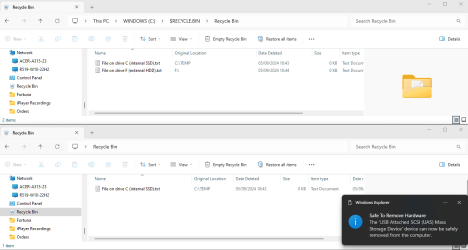- Local time
- 3:52 PM
- Posts
- 686
- OS
- Windows 11 Pro Insider 64 bit 25H2 26200.5670
If you delete a file from your External HDD and then disconnect it before emptying the Recycle Bin, the files still remain in $RecycleBin. When you reconnect it and then Empty the Recycle Bin on the C: drive, it will not empty the $RecycleBin. You have to use Disk Cleanup or Storage Sense to empty that Recycle bin.Doing a Disk Cleanup, or in System/System/Storage/Storage Sense/Cleanup Recommendations and deleting all temp files should empty it.
Or be sure to Empty the Recycle bin before disconnecting your external HDD.
My Computer
System One
-
- OS
- Windows 11 Pro Insider 64 bit 25H2 26200.5670
- Computer type
- PC/Desktop
- Manufacturer/Model
- Gigabyte Z390 UD
- CPU
- Intel Core i7 9700K 3.60
- Motherboard
- Gigabyte Z390 UD
- Memory
- 16 GB
- Graphics Card(s)
- nVidia GEForce RTX 2060 Super
- Sound Card
- onboard
- Monitor(s) Displays
- Two 27" Dell 4K monitors
- Screen Resolution
- 3840 x 2160
- Hard Drives
- M.2 NVME SSD, 500 GB; Two 2TB Mechanical HDD's
- PSU
- 850w PSU
- Case
- Cyberpower PC
- Cooling
- Water cooled
- Keyboard
- Backlit Cyberpower gamiong keyboard
- Mouse
- Backlit Cyberpower gaming mouse
- Internet Speed
- 1 GB mbps
- Browser
- Brave
- Antivirus
- Windows Security







